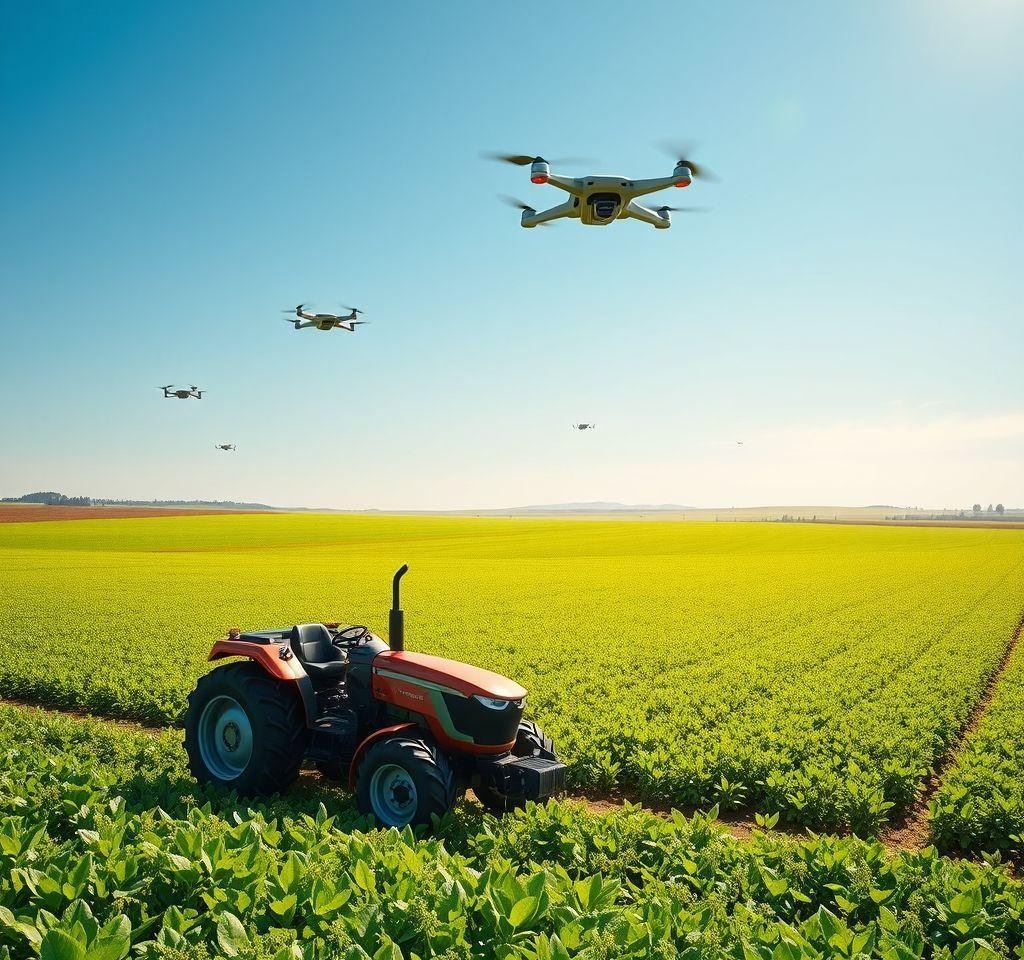Precision Farming with AI: Revolutionizing Agriculture
Precision farming, aided by artificial intelligence (AI), is transforming agriculture, leading to optimized resource utilization, increased yields, and sustainable practices. AI-powered technologies provide real-time insights into crop health, soil conditions, and weather patterns. This allows farmers to make data-driven decisions, maximizing efficiency and minimizing waste.
Introduction to Precision Farming and AI
Precision farming leverages technology to optimize resource use and improve yields. AI is integrated through sensors, drones, and data analytics. Historically, AI’s role was limited; however, it now plays a crucial role in decision-making. AI offers opportunities for enhanced farm management, precise resource allocation, and improved crop monitoring. Challenges include data accessibility, infrastructure limitations, and the cost of implementation. For instance, AI algorithms analyze satellite imagery to identify areas requiring irrigation. This enables targeted water use, minimizing waste and maximizing crop health. The future holds even more sophisticated applications. AI will continue to be a transformative force, improving efficiency and sustainability in agriculture.
AI-Driven Crop Monitoring and Management
Precision farming leverages technology to optimize resource use and improve yields. AI is integrated through sensors, drones, and data analytics. Historically, AI’s role was limited; however, it now plays a crucial role in decision-making. AI offers opportunities for enhanced farm management, precise resource allocation, and improved crop monitoring. Challenges include data accessibility, infrastructure limitations, and the cost of implementation. For instance, AI algorithms analyze satellite imagery to identify areas requiring irrigation. This enables targeted water use, minimizing waste and maximizing crop health. The future holds even more sophisticated applications. AI will continue to be a transformative force, improving efficiency and sustainability in agriculture.
AI for Resource Optimization in Precision Farming
Precision farming leverages technology to optimize resource use and improve yields. AI is integrated through sensors, drones, and data analytics. Historically, AI’s role was limited; however, it now plays a crucial role in decision-making. AI offers opportunities for enhanced farm management, precise resource allocation, and improved crop monitoring. Challenges include data accessibility, infrastructure limitations, and the cost of implementation. For instance, AI algorithms analyze satellite imagery to identify areas requiring irrigation. This enables targeted water use, minimizing waste and maximizing crop health. The future holds even more sophisticated applications. AI will continue to be a transformative force, improving efficiency and sustainability in agriculture.
Challenges and Opportunities in AI-Driven Precision Farming
Precision farming leverages technology to optimize resource use and improve yields. AI is integrated through sensors, drones, and data analytics. Historically, AI’s role was limited; however, it now plays a crucial role in decision-making. AI offers opportunities for enhanced farm management, precise resource allocation, and improved crop monitoring. Challenges include data accessibility, infrastructure limitations, and the cost of implementation. For instance, AI algorithms analyze satellite imagery to identify areas requiring irrigation. This enables targeted water use, minimizing waste and maximizing crop health. The future holds even more sophisticated applications. AI will continue to be a transformative force, improving efficiency and sustainability in agriculture.
The Future of Precision Farming with AI
Precision farming leverages technology to optimize resource use and improve yields. AI is integrated through sensors, drones, and data analytics. Historically, AI’s role was limited; however, it now plays a crucial role in decision-making. AI offers opportunities for enhanced farm management, precise resource allocation, and improved crop monitoring. Challenges include data accessibility, infrastructure limitations, and the cost of implementation. For instance, AI algorithms analyze satellite imagery to identify areas requiring irrigation. This enables targeted water use, minimizing waste and maximizing crop health. The future holds even more sophisticated applications. AI will continue to be a transformative force, improving efficiency and sustainability in agriculture.
Introduction to Precision Farming and AI
AI significantly enhances crop monitoring and management. Computer vision algorithms analyze images to detect diseases and identify weeds. Drones and satellites provide large-scale monitoring capabilities. Data analysis and predictive modeling optimize resource use, improving irrigation, fertilization, and pest control. Successful strategies include using AI to predict yields, enabling proactive adjustments in resource allocation. This precision approach leads to improved efficiency and reduced waste. The integration of AI is transforming agricultural practices, leading to higher yields and more sustainable farming methods.
AI-Driven Crop Monitoring and Management
AI significantly enhances crop monitoring and management. Computer vision algorithms analyze images to detect diseases and identify weeds. Drones and satellites provide large-scale monitoring capabilities. Data analysis and predictive modeling optimize resource use, improving irrigation, fertilization, and pest control. Successful strategies include using AI to predict yields, enabling proactive adjustments in resource allocation. This precision approach leads to improved efficiency and reduced waste. The integration of AI is transforming agricultural practices, leading to higher yields and more sustainable farming methods.
AI for Resource Optimization in Precision Farming
AI significantly enhances crop monitoring and management. Computer vision algorithms analyze images to detect diseases and identify weeds. Drones and satellites provide large-scale monitoring capabilities. Data analysis and predictive modeling optimize resource use, improving irrigation, fertilization, and pest control. Successful strategies include using AI to predict yields, enabling proactive adjustments in resource allocation. This precision approach leads to improved efficiency and reduced waste. The integration of AI is transforming agricultural practices, leading to higher yields and more sustainable farming methods.
Challenges and Opportunities in AI-Driven Precision Farming
AI significantly enhances crop monitoring and management. Computer vision algorithms analyze images to detect diseases and identify weeds. Drones and satellites provide large-scale monitoring capabilities. Data analysis and predictive modeling optimize resource use, improving irrigation, fertilization, and pest control. Successful strategies include using AI to predict yields, enabling proactive adjustments in resource allocation. This precision approach leads to improved efficiency and reduced waste. The integration of AI is transforming agricultural practices, leading to higher yields and more sustainable farming methods.
The Future of Precision Farming with AI
AI significantly enhances crop monitoring and management. Computer vision algorithms analyze images to detect diseases and identify weeds. Drones and satellites provide large-scale monitoring capabilities. Data analysis and predictive modeling optimize resource use, improving irrigation, fertilization, and pest control. Successful strategies include using AI to predict yields, enabling proactive adjustments in resource allocation. This precision approach leads to improved efficiency and reduced waste. The integration of AI is transforming agricultural practices, leading to higher yields and more sustainable farming methods.
Introduction to Precision Farming and AI
AI optimizes resource allocation in precision farming by analyzing data from sensors and IoT devices. This real-time monitoring informs AI algorithms, predicting optimal resource application. Factors considered include soil conditions, weather patterns, and crop needs. AI-driven irrigation minimizes water waste. Smart fertilizer application reduces environmental impact and cost. Predictive pest control minimizes pesticide use. Labor optimization improves efficiency, reducing costs. Case studies show significant economic and environmental benefits from AI-powered resource optimization.
AI-Driven Crop Monitoring and Management
AI optimizes resource allocation in precision farming by analyzing data from sensors and IoT devices. This real-time monitoring informs AI algorithms, predicting optimal resource application. Factors considered include soil conditions, weather patterns, and crop needs. AI-driven irrigation minimizes water waste. Smart fertilizer application reduces environmental impact and cost. Predictive pest control minimizes pesticide use. Labor optimization improves efficiency, reducing costs. Case studies show significant economic and environmental benefits from AI-powered resource optimization.
AI for Resource Optimization in Precision Farming
AI optimizes resource allocation in precision farming by analyzing data from sensors and IoT devices. This real-time monitoring informs AI algorithms, predicting optimal resource application. Factors considered include soil conditions, weather patterns, and crop needs. AI-driven irrigation minimizes water waste. Smart fertilizer application reduces environmental impact and cost. Predictive pest control minimizes pesticide use. Labor optimization improves efficiency, reducing costs. Case studies show significant economic and environmental benefits from AI-powered resource optimization.
Challenges and Opportunities in AI-Driven Precision Farming
AI optimizes resource allocation in precision farming by analyzing data from sensors and IoT devices. This real-time monitoring informs AI algorithms, predicting optimal resource application. Factors considered include soil conditions, weather patterns, and crop needs. AI-driven irrigation minimizes water waste. Smart fertilizer application reduces environmental impact and cost. Predictive pest control minimizes pesticide use. Labor optimization improves efficiency, reducing costs. Case studies show significant economic and environmental benefits from AI-powered resource optimization.
The Future of Precision Farming with AI
AI optimizes resource allocation in precision farming by analyzing data from sensors and IoT devices. This real-time monitoring informs AI algorithms, predicting optimal resource application. Factors considered include soil conditions, weather patterns, and crop needs. AI-driven irrigation minimizes water waste. Smart fertilizer application reduces environmental impact and cost. Predictive pest control minimizes pesticide use. Labor optimization improves efficiency, reducing costs. Case studies show significant economic and environmental benefits from AI-powered resource optimization.
Introduction to Precision Farming and AI
Implementing AI in agriculture faces challenges like data scarcity, infrastructure limitations, high costs, and a shortage of skilled personnel. Ethical concerns include data privacy, algorithmic bias, and the potential impact on rural communities. Future opportunities involve advancements in AI technologies, such as improved sensor networks and more robust algorithms. Research should focus on addressing data limitations, developing more explainable AI models, and mitigating potential biases. These advancements will likely lead to more sustainable and efficient farming practices, benefiting both farmers and the environment.
AI-Driven Crop Monitoring and Management
Implementing AI in agriculture faces challenges like data scarcity, infrastructure limitations, high costs, and a shortage of skilled personnel. Ethical concerns include data privacy, algorithmic bias, and the potential impact on rural communities. Future opportunities involve advancements in AI technologies, such as improved sensor networks and more robust algorithms. Research should focus on addressing data limitations, developing more explainable AI models, and mitigating potential biases. These advancements will likely lead to more sustainable and efficient farming practices, benefiting both farmers and the environment.
AI for Resource Optimization in Precision Farming
Implementing AI in agriculture faces challenges like data scarcity, infrastructure limitations, high costs, and a shortage of skilled personnel. Ethical concerns include data privacy, algorithmic bias, and the potential impact on rural communities. Future opportunities involve advancements in AI technologies, such as improved sensor networks and more robust algorithms. Research should focus on addressing data limitations, developing more explainable AI models, and mitigating potential biases. These advancements will likely lead to more sustainable and efficient farming practices, benefiting both farmers and the environment.
Challenges and Opportunities in AI-Driven Precision Farming
Implementing AI in agriculture faces challenges like data scarcity, infrastructure limitations, high costs, and a shortage of skilled personnel. Ethical concerns include data privacy, algorithmic bias, and the potential impact on rural communities. Future opportunities involve advancements in AI technologies, such as improved sensor networks and more robust algorithms. Research should focus on addressing data limitations, developing more explainable AI models, and mitigating potential biases. These advancements will likely lead to more sustainable and efficient farming practices, benefiting both farmers and the environment.
The Future of Precision Farming with AI
Implementing AI in agriculture faces challenges like data scarcity, infrastructure limitations, high costs, and a shortage of skilled personnel. Ethical concerns include data privacy, algorithmic bias, and the potential impact on rural communities. Future opportunities involve advancements in AI technologies, such as improved sensor networks and more robust algorithms. Research should focus on addressing data limitations, developing more explainable AI models, and mitigating potential biases. These advancements will likely lead to more sustainable and efficient farming practices, benefiting both farmers and the environment.
Introduction to Precision Farming and AI
AI-driven precision farming is transforming agriculture. It improves efficiency, sustainability, and profitability. Key aspects include AI-powered crop monitoring, resource optimization, and predictive modeling. Emerging trends like edge computing, blockchain technology, and advanced robotics will further shape the future. Edge computing enables faster data processing at the farm level. Blockchain enhances data security and traceability. Advanced robotics automates tasks, increasing efficiency. Long-term, AI will be crucial for food security and global agricultural production. It helps meet growing food demands sustainably.
AI-Driven Crop Monitoring and Management
AI-driven precision farming is transforming agriculture. It improves efficiency, sustainability, and profitability. Key aspects include AI-powered crop monitoring, resource optimization, and predictive modeling. Emerging trends like edge computing, blockchain technology, and advanced robotics will further shape the future. Edge computing enables faster data processing at the farm level. Blockchain enhances data security and traceability. Advanced robotics automates tasks, increasing efficiency. Long-term, AI will be crucial for food security and global agricultural production. It helps meet growing food demands sustainably.
AI for Resource Optimization in Precision Farming
AI-driven precision farming is transforming agriculture. It improves efficiency, sustainability, and profitability. Key aspects include AI-powered crop monitoring, resource optimization, and predictive modeling. Emerging trends like edge computing, blockchain technology, and advanced robotics will further shape the future. Edge computing enables faster data processing at the farm level. Blockchain enhances data security and traceability. Advanced robotics automates tasks, increasing efficiency. Long-term, AI will be crucial for food security and global agricultural production. It helps meet growing food demands sustainably.
Challenges and Opportunities in AI-Driven Precision Farming
AI-driven precision farming is transforming agriculture. It improves efficiency, sustainability, and profitability. Key aspects include AI-powered crop monitoring, resource optimization, and predictive modeling. Emerging trends like edge computing, blockchain technology, and advanced robotics will further shape the future. Edge computing enables faster data processing at the farm level. Blockchain enhances data security and traceability. Advanced robotics automates tasks, increasing efficiency. Long-term, AI will be crucial for food security and global agricultural production. It helps meet growing food demands sustainably.
The Future of Precision Farming with AI
AI-driven precision farming is transforming agriculture. It improves efficiency, sustainability, and profitability. Key aspects include AI-powered crop monitoring, resource optimization, and predictive modeling. Emerging trends like edge computing, blockchain technology, and advanced robotics will further shape the future. Edge computing enables faster data processing at the farm level. Blockchain enhances data security and traceability. Advanced robotics automates tasks, increasing efficiency. Long-term, AI will be crucial for food security and global agricultural production. It helps meet growing food demands sustainably.
Final Words
Precision farming with AI is revolutionizing agriculture, offering immense potential for increased efficiency, sustainability, and profitability. By embracing AI-driven technologies, farmers can optimize resource allocation, improve crop yields, and reduce environmental impact. The future of agriculture hinges on integrating AI into farming practices to ensure food security and sustainable growth. This technology will continue to evolve, leading to even more innovative solutions in the years to come.




